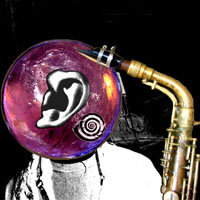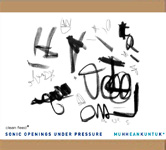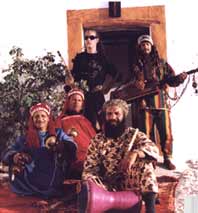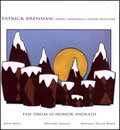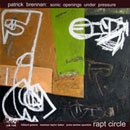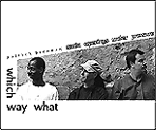Music
sweeps in...as a fully fledged instrument of thought. For the
same reasons that make it suspect in Plato's and Kant's eyes,
music escapes from the concept. Philosphers can describe its
theoretical codes...but the musical effect escapes philosophy
as it still escapes the human sciences today. ...discontinuity
they search for, and hatred of the subject's imprisonment in
a system of thought. It is a syncope of thought. -
Catherine Clément
|
present
personic |
 CLICK
IMAGE CLICK
IMAGE CLICK
IMAGE IMAGE
CLICK
CLICK
CLICK
IMAGE CLICK
IMAGE CLICK
IMAGE IMAGE
CLICK
CLICK |
|
|
Sunday
November 2
3-3:30 pm
TRIBES
IDEA KITCHEN
285 E3st (C&D)
NYC
|
|
|
|
Africans
gave us a way to see the multi-layered authenticity of human experience
through polyrhythm and syncopation. That gift allows us to realize a
daily connection to the essential motion of all things. -
David Pleasant
see: IDEAS
IN MOTION
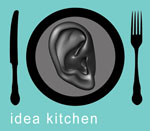 |
|
idea
kitchen
at TRIBES
285 E 3 St., 2nd Fl., (Bet C & D) NYC
1st Sunday of each month 3 -- 5:30 pm.
a new guest composer each month
organized by patrick brennan w/ Steve Cannon
|
This
is an unfunded musician initiative for musicians & interested
listeners to create one setting where musicians can share ideas
& learn from each other, where compositional ideas get worked
out in a public domain among a variety of personalities &
dispositions. For listeners, this is about demystifying music
& ... click
here for more info |
sonic
openings under pressure |
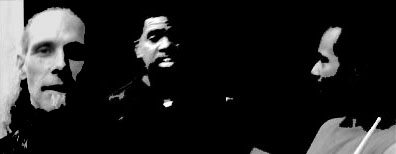 |
CLICK
IMAGE for:
INFO ABOUT THE MUSIC
PERFORMANCES RESIDENCIES
& EDUCATION BIOS
SOUND VIDEO SCORES
PRESS INTERVIEW |
|
|
|
new release:
muhheankuntuk
patrick brennan
- saxophone
David Pleasant
- -- Densemetrix!
Hilliard Greene
- - --- - bass
|
|
|
Many
observers have theorized that jazz, taken to the
brink by the rhythmic fury and apocalyptic questing
of John Coltrane's late-'60s bands, played itself
into a corner with nowhere left to go. patrick brennan
and his elegant and fiery band just may have found
a way back out, a sonic opening, if you will. -
John
Chacona |
|
|
We are moved by music because musicking creates
the public image of our most inwardly desired relationships, not just
showing them to us as they might be but actually bringing
them into existence for the duration of the performance.
This will clearly involve our deepest feelings, and thus the act of
musicking, taking place over a duration of time, teaches us what we
really feel about ourselves and about our relationships to other people
and to the world in general, helping us to structure those feelings
and therefore to explore and evolve our own identity.
Clifford Geertz has said: 'In order to make up our minds we must know
what we feel about things; and to know how we feel we need the public
images of sentiment that only ritual, myth and art can provide'
And again: 'Human thought is basically both social and public - its
natural habitat is the house yard, the marketplace and the town square.
Thinking consists not of 'happenings in the mind', (though happenings
there and elsewhere are necessary for it to occur) but of a traffic
in significant symbols -
- or as Alice might have said, 'How do I know what I feel until I hear
what I play?' In musicking, in fact we are being touched in the deepest
parts of who we are. - Christopher Small
sudani
project |
|
CLICK
IMAGE |
|
|
patrick
brennan, Najib Sudani, Nirankar Khalsa and company build
upon the commonalities of African-American and African-Maghribi
music not only at the level of melody and rhythm, but also
at a deeper level of interactive structure, each one giving
and taking in turn. Sensitive listening on the part of each
musician and a willingness to follow each other without
being bound by typical genre constraints makes this recording
one of the most satisfying and genuinely collaborative Gnawa
explorations to date. - Dr.
Tim Fuson
|
|
Entrainment
is the term coined by William Condon for the process that occurs when
two or more people become engaged in each other's rhythms....
...music is a highly specialized releaser of rhythms already in the
individual.... Music can also be viewed as a rather remarkable extension
of the rhythms generated in human beings....
the definition of the self is deeply embedded in the rhythmic synchronic
process. This is because rhythm is inherent in organization, and therefore
has a basic design function in the organization of the personality.
Rhythm cannot be separated from process and structure; in fact one can
question whether there is such a thing as an eventless rhythm. Rhythmic
patterns may turn out to be one of the most important basic personality
traits that differentiate one human being from the next.
All human rhythms begin in the center of the self, that is with self-synchrony.
Even brain rhythms are reliable indicators associated with practically
everything that people do.... - Edward T. Hall
Every instrument a drum
Sonic
Openings Under Pressure makes
precise yet adventurously rhythmic jazz
by John
Chacona
You
could make the case that Detroit in the 1960s changed the direction
of American music. In pop music, the immensely popular string
of R&B hits from the Motown label raised rhythm above melody
in American -- and maybe even world -- pop.
At
the same time, as the inner-city studios of Hitsville U.S.A. was
making "The Sound of Young America," another rhythmic
revolution was quietly going on just a couple blocks away. So
quietly, in fact, that most musicians are still unaware of it.
patrick
brennan is not among them. As a teenage saxophonist, brennan heard
firsthand what almost-forgotten players like saxophonist Leon
Henderson (Joe's brother) and drummer Bud Spangler were doing
in out-of-the-way venues such as the Strata Concert Gallery.
"What
I was hearing was all these polyrhythmic structures that resembled
the kind of things that Miles was doing, but they did it in a
more deliberate compositional fashion," brennan told me by
phone from his New York home.
"It
took me years to decode it, but it made a big impression on me.
That and following the music back ... to Africa."
When
asked if being unschooled contributed to his saxophone sound,
Brennan described himself as "schooled and a half. I like
to play Charlie Parker backwards, but I don't have any feeling
that I need to do that in my own music." While this seems
to imply that brennan is an anything-goes free improviser of the
"energy music" school, the saxophonist doesn't see it
that way.
True,
the music played by his latest Sonic Openings band has energy
to burn, most of it emanating from the extraordinary drummer David
Pleasant. But brennan's approach is rigorously compositional.
"Look,
there's no such thing as music without composition, because there's
always agreement, right? I slowly started to work with a language
that made the whole band think rhythmically like the drummer,
so that the tactility and the sculptural elements of rhythm become
more prominent."
Naturally,
Pleasant is central to this concept.
"When
he joined the group, he took stuff that takes people six months
to learn and got it in a couple of hours. He's Gullah Geechee
[from the Sea Islands of Georgia], born in Savannah, and he keeps
these polyrhythms going. He knows exactly what he's doing."
Many
observers have theorized that jazz, taken to the brink by the
rhythmic fury and apocalyptic questing of John Coltrane's late-'60s
bands, played itself into a corner with nowhere left to go.
patrick brennan and his elegant and fiery band just may have found
a way back out, a sonic opening, if you will.
Erie
Times-News ShowCase - October 26. 2006
- -http://www.johnchacona.com
|
about
the music: sonic
openings under pressure |
|
This
is music composed specifically to unfold through collective
improvisation, which means that the form of the music
itself is directly shaped through mutual interplay among
its participants, and that collaborative drama contributes
centrally to the musical narrative a listener hears.
This approach to coordinating music poses a deliberate
alternative to the relative one way flow of information
that passes between composer & performer in much euroclassical
practice as well as to that genre’s orientation
toward the construction of sonic monuments, a propensity
also shared by much pop music. Pop formulations furthermore
have tended to compress rhythmic scope down to basic denominator
background beats. And, while much contemporary improvised
music may emulate open form as developed through jazz,
the root African elements & attitudes out of which
this evolved have many times been distilled out.
Collective improvisation can also be recognized as a theatrical
personification of the dynamics of polyrhythm - that intricately
sophisticated African model of coordinated multiplicity.
Polyphonically organized music is able to integrate divergent
voices, levels, directions & narratives; but the wave
matrix of polyrhythm’s gravitational convergences
& suspensions further enriches each moment of music
with a holographic sensation of depth. This especially
charges & activates the gaps & silences that envelop
musical gestures & encourages attention beyond linear
& sequential interpretations of activity to include
more multidimensional perceptions of time & movement.
This music often explores making polyrhythm central to
the organization & participation of the entire ensemble.
One strategy has been to code polyrhythm into the music
via a stacking of interrelated countermelodies that places
each instrumentalist in a position of direct responsibility
for the composite ensemble sound. The countermelodies
- & the relationships among them - provide a thematic
interface that supports both extemporized development
& communications among improvisers as the music progresses.
MetagrooveTM
is an allied compositional process that associates successive,
contrasting polyrhythmic constellations (i.e. grooves)
to create a overall groovic resonance (in other words,
a meta- groove).
Each voice in this ensemble maintains an equal distinct
narrative foreground persona; & it follows that much
of the compositional focus has been on developing music
through the rhythm section. As Bakongo scholar Fu-Kiau
Bunseki has put it, “Treble voicings represent our
world, but bass patterns come from the spirit.”
The bass not only carries on an independent melodic narrative
at a pace appropriate to its register, but often functions
as conductor of the ensemble, cueing shifts from one metagrooveTM
constellation to the next. These shifts are also multidirectionally
jointed, allowing an overall form to wrap around itself
& construct an ensemble narrative that’s more
oriented toward immersion than linear progression from
beginning to end.
It’s also natural that drums figure prominently
in a music that explores rhythmic harmony & multidirectional
movement. Some listeners may at first be disoriented by
percussion’s abundant role here. But, as a trap
kit enables the playing of as many as four simultaneous
lines, it can also be considered as contributing more
than one instrument to the ensemble. The non-tempered
tones enunciated by drums contribute a significant component
of this music’s melodic & tonal framework. Even
a casual listening to Dou Dou Njaye Rose’s orchestra
of sabar wolofs from Dakar, for example, can reinforce
a recognition that drums, all by themselves, have more
than enough range to enact complete & nuanced statements
on as high a level as any music.
Some market oriented & cultural perspectives argue
that music shouldn’t overly stretch or challenge
listeners’ imaginations. Contrarily, this music
aims toward a threshold where some aspect is slipping
just enough beyond a listener’s comprehension to
invite a sense of wonder & mystery as a small reminder
that there’s always something more happening anywhere
than is already known & recognized.
-
patrick brennan
|
| |
RECORDINGS
from
sonic openings under pressure |
|
|
muhheankuntuk
Clean
Feed #CF081
The
title of this CD by the sonic openings under pressure
troupe is the term used by the Lenape nation to name
the Hudson River, and it means "river that flows
two ways". The music acts accordingly, and surely
is a New York product. Everything happening in these
tracks has those two interactive sides; one open,
the second closed in such a way that some materials
are getting out, going very far away, while others
are coming in, adjusting to the roots and identity
of the "great black tradition," with a conscious
and determined attitude. So, if your foot taps and
your heart rejoices with this music, your mind will
awaken..
with
David Pleasant-Densemetrix!, Hilliard
Greene-bass
Recorded June 13, 2006. |
|
|
|
the
drum is honor enough CIMP
#305
Listening
to patrick brennan's music is a bit like looking at
a bowl that has been shattered and reassembled but
whose fit isn't quite right: you know what it is when
looking at it, but it requires some reassessment to
take it all in. Extensive Artist and Producer Notes
may take you one listen just to get through, another
listen to digest, but by the third listen the joy
and genius of this concert should be evident. A valuable
addition to this veteran's slight but growing discography.
with
Newman Taylor Baker-drums, Hilliard
Greene-bass, Steve Swell-trombone
Recorded February 17 & 18, 2004.
|
|
| |
rapt
circle Cadence
Jazz Records 1168
Recorded
live 3 weeks apart in June 2002 at the Montreal Jazz
Festival and the Vision Festival. A sly rhythm falling
in and out of funk initiates the series of transitory
time signatures, never without the sweat of the blues.
At times the writing resembles dub, with an instrument
dropping out at a time shift, resuming at the next
change. Brennan calls "metagroove...a synthesis
of juxtapositions of contrasting grooves" creating
an overall groove. CJR would call it a hip dialogue
built off (talking) drums projecting light where there
is none through interactive improvisation. Or you
could just sit back and enjoy the the expositions
and declarations of these fine improvising minds.
with
Newman Taylor Baker-drums, Hilliard
Greene-bass, Juma Santos Ayantola-dun
dun & percussion Recorded June, 2002.
|
|
|
|

|
sudani
deep
dish
dd-104
patrick
brennan, Najib Sudani, Nirankar Khalsa and company
build upon the commonalities of African-American and
African-Maghribi music not only at the level of melody
and rhythm, but also at a deeper level of interactive
structure, each one giving and taking in turn. Sensitive
listening on the part of each musician and a willingness
to follow each other without being bound by typical
genre constraints makes this recording one of the
most satisfying and genuinely collaborative Gnawa
explorations to date.
with
M'allim Najib Sudani-guimbri, voice,
t'bal, Nirankar Khalsa-drums, voice,
flute Recorded May, 1999 near Essaouira, Morocco.
|
|
|
which
way what deep
dish dd-103
There's
little more to say about this album other than to
recommend it very highly. brennan's an abstract expressionist
with chops. He's utterly coherent in his free associative
improvisations, and he imbues his music with a great
deal of timbral and rhythmic variety. His compositions
are fresh and quite original. patrick brennan's a
first class saxophonist and composer, and his trio
is one of the most interesting I've heard in some
time.
with
Rachiim Ausar-Sahu-bass, Acácio
Salero Cardoso-drums
Recorded August, 1995.
|
|
|
|

